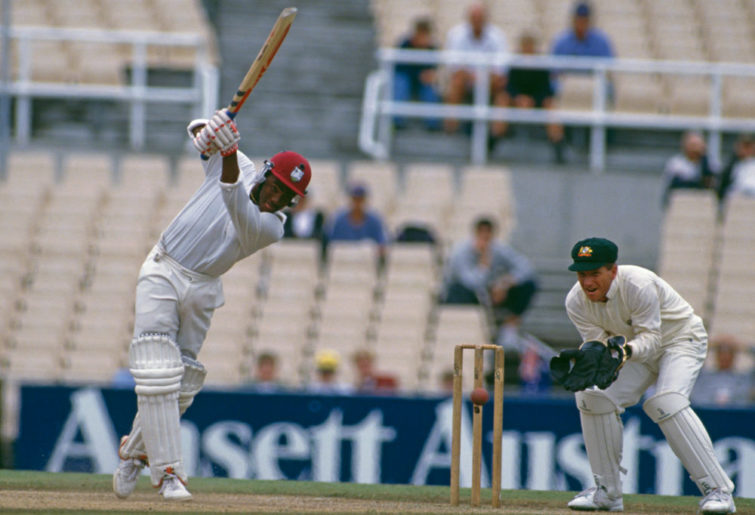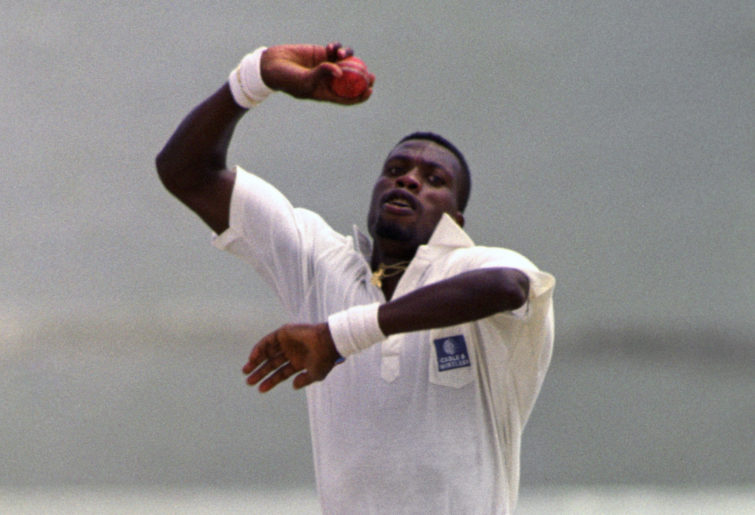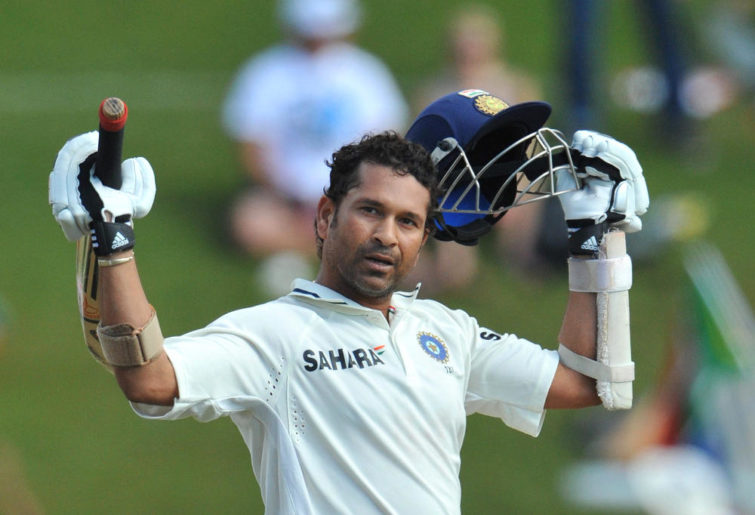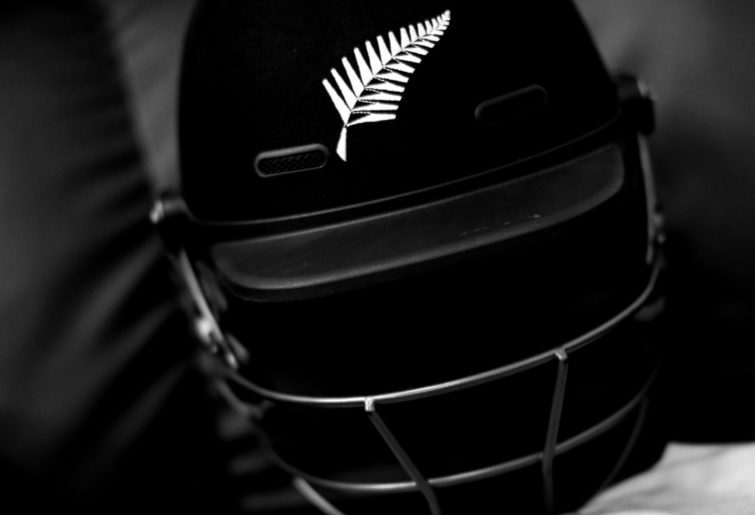Moving onto the 1990s, the front runner for second best in the 1990s is actually the West Indies since they clung onto their crown, however grimly, until early to mid-1995.
Let’s look at what they did both prior and beyond that 1995 series against Mark Taylor’s Australians.
The Windies began this decade by losing the first Test of the home series against England in early 1990. This was the first series for either team since the triumphant Australian Ashes tour of 1989.
When asked what he thought of England’s first Test victory, Allan Border said: “I was… not proud… but, you know, I thought it was fantastic to see – it made our Ashes performances (1989) look even better!”
England would go on to narrowly lose that series 1-2, but they were robbed in one of the draws when the West Indies unsportingly went to exaggerated lengths to slow down the over rate when England were well on the way to victory.
Viv Richards justified this in his autobiography Hitting Across the Line with: “Stand-in captain Desmond Haynes had no choice but to do what he did, but yes, I have to admit, England were robbed in that game”.
The next time these two teams met was in England in 1991, and the rubber was drawn at 2-all in a five-Test series. The time after that was in the Caribbean in early 1994, barely a year after Brian Lara’s coming of age with his 277 in Sydney.

(Photo by Joe Mann/Getty Images)
The West Indies were 3-0 up after three Tests, but the third of those involved a collapse of 46 all out chasing 190 and England went on to win the fourth with the fifth drawn with scores of 5-593 and 593 all out.
In that 46 debacle, Curtly Ambrose took 6-24, and Courtney Walsh four for less than 24 and this was a familiar theme between early 1992 and late ’94 – Ambrose and Walsh bailing the West Indies out in the wake of no longer having the powerful batting line-ups of the 1980s.
Four times this happened including a one-off Test, their inaugural against the readmitted South Africa. The other three occasions involved avoiding a drawn series (that same 1994 home series against England) and avoiding two series defeats prior to 1995 (in Australia 1992-93 and India 94-95) in the wake of the exodus of star players in 1991.
The next time England and the West Indies met was right after the Australian Caribbean victory in mid-1995 in England. That series was 2-2 and the West Indies should have won it, being 2-1 up after three, and then squandering the fourth, and then allowing the last two to meander away to high-scoring draws. However, the West Indies won their home series against England in 1998.
After the 1995 dethroning at Australia’s hands, the West Indies lost four more series to the end of the 1990s: the follow-up series here in Aussie land in 1996-97, a 0-3 drubbing in Pakistan a year later, a 0-5 drubbing in the Veldt in 1998-99 and then a 0-2 loss in New Zealand right at the end of 1999.
Outside of those series between 1995 and the end of 1999, they beat New Zealand at home in early 1996, then beat India 1-0 in a five-Test series at home a year later, and also at home in early to mid-1997 they beat Sri Lanka in a two-Test series.

(Photo by Rebecca Naden – PA Images/PA Images via Getty Images)
Their only other Test match assignment before the new century and millennium was when the rampaging Aussies toured the Caribbean in early 1999 and that series was squared at Lara two, Australia two. By 2000, all of Ambrose, Walsh and Ian Bishop were finished and the West Indies have not produced a world-class pace bowler since, nor a genuine class batsman since Shivnarine Chanderpaul, who played throughout most of the following decade.
Sri Lanka were no longer minnows in the 1990s, but given they were also nowhere near the top, it is not necessary to discuss their 1990s performances unless there is a tie-breaker later among the genuine contenders for second, third, fourth, fifth, and sixth spots.
The same applies to New Zealand, who were no longer the competitive unit punching above their weight that they had been in the 1980s – New Zealand did nothing significant on the Test front in the 1990s except to defeat England in England in 1999.
The only teams they even beat at home in that decade were Zimbabwe, Sri Lanka, and then India and the West Indies in early and late 1999 respectively.
Having already dissected their very credible performances against the West Indies during the 1990s, let’s examine England next, starting with their pits: Ashes contests.
In 27 Ashes Tests during the 1990s, England won only one solitary match when the destiny of the Ashes were still undecided, obviously losing all five series played during this decade, two at home, and three away down under.
Against Pakistan, England lost convincingly at home in both 1992 and ’96, but for some reason never travelled to Pakistan during that decade.
Against India, England won at home in both 1990 and 1996 but suffered a 0-3 drubbing in India in 1992-93.

(Duif du Toit / Gallo Images/Getty Images)
They won a one-off Test at home against Sri Lanka in 1991, but lost a one-off home Test against the same opponents in 1998. They also lost a one-off Test in Sri Lanka in 1992-93. So in total, England played only four Tests in total anywhere on the sub-continent during the 1990s and lost all four.
During the 1990s, England played three series at home against New Zealand, winning in 1990 and ’94, and losing in ’99. They beat New Zealand in New Zealand in ’91-92 and ’96-97, both times 2-0.
Against South Africa, England drew 1-1 at home in 1994 and won 2-1 in 1998. They lost in South Africa 1-0 in 1995-96 and 2-0 in a series down around the Cape of Good Hope that began in late 1999 and concluded early in 2000.
South Africa themselves began their second coming in international cricket in early 1992 against the West Indies in Bridgetown, the first time these teams had ever played each other in an official Test match.
The match saw two firsts: the first of a series of great Houdini escapes by the West Indies in the 1991-94 period and the first of many chokes by the Proteas: controlling the game for the first four days, they lost 8-26 on the fifth morning, having begun it needing only 79 for victory with those eight wickets still standing. The next time these two teams met was the aforementioned 5-0 whitewash by the Proteas in 1998-99.
Series between South Africa and England during the 1990s have already been outlined. South Africa played New Zealand once at home and one away during the 1990s and not surprisingly won both series.
They beat India at home in 1992-93, but lost in India ’96-97. They played a one-off Test at home against Pakistan in 1994-95 and won it and then actually beat Pakistan 1-0 in a three-Test series in Pakistan in 1997-98, almost a full year before Australia finally managed to win there.
South Africa’s 1-0 victory in Sri Lanka in late 1993 actually resembled Australia’s of a year earlier, a couple of years before Australia took the unofficial crown of world champions.

(Credit: Ben Radford/Allsport/Getty Images)
Not surprisingly, South Africa also comfortably put Sri Lanka away when they toured the Rainbow Nation in late 1997.
Against Australia is where South Africa really ran aground in the 1990s and this was no doubt mainly due to the fact that they did not have a batsman that could hurt us of the calibre of say Brian Lara or Sachin Tendulkar.
After a lucky win in Sydney in January 1994, Australia were able to square that rubber before moving on to the South African leg, which also resulted in a drawn series. With Border having given way to Taylor, Australia trounced South Africa both there and here at either end of 1997.
That leaves Pakistan. Pakistan in the 1990s were not dissimilar to the 1980s. They probably had even more class in batting and bowling, but what they did not have was Imran Khan’s leadership. As noted, they won two series in England during the 1990s, and the only other team to do likewise was Australia.
As noted they lost at home against South Africa, Sri Lanka and Australia, but in the 1995 home loss to Sri Lanka, they were missing some key players for Tests 2 and 3. They lost in the Caribbean in early 1993 before the ’95 dethroning of the Calypsos but then they beat them 3-0 at home in Pakistan as already outlined.
Apart from losing 0-1 at home to Australia in late 1998, they were fortunate to prevail 1-0 against us four years earlier, and were trounced 2-1 and 3-0 out here in 1995-96 and four years later.
Political hostilities saw India and Pakistan play each other only once in the ’90s, 1998-99 for a 1-1 draw. India themselves are not seriously in the running for spots two to five for this decade, as the only remotely significantly thing they did was defeat Australia at home in early 1998 when we were missing at least one key fast bowler.

(Steven Paston – EMPICS/Getty Images)
So now to the summation and compared to the 1990s it is a dog’s breakfast for two reasons: firstly, there are two extra teams, and secondly, everyone played considerably more Tests so it’s more difficult to analyse.
At first glance, there is no doubt that the West Indies did considerably better across the whole decade against Australia than any other team, winning in 1991 when they were still kings, conjuring up one of their post-’91 but pre-’95 Houdini escapes out here in ’92-93 and then earning a drawn series in ’99 that was kind of on a par to Australia’s credible 1-1 draw against the same opposition in 1981-82.
Throughout the 1990s, the West Indies won eight Tests against Australia that weren’t dead rubbers. The other contenders for the number two spot for the ’90s, South Africa, Pakistan and England, won two, one and one respectively when it came to winning non-dead rubber Tests against us that decade.
However, while the West Indies did not lose a further series at home after 1995 for the rest of that decade, they also did not win one anywhere else, and they lost precisely one per year, all bar one of them whitewashes.
The West Indies began the decade in a similar position to the Roman Empire when it split itself in two in 395 CE. Post-2000, the once proud Caribbean dynasty very quickly disintegrated into similar chaos as the post-476 CE Roman Empire, overrun from all directions by marauders, out for revenge for previous atrocities.
For this reason, I place England above the West Indies for the 1990s at four and five respectively. India are six and Sri Lanka are at seven, ahead of New Zealand, who they played three times in New Zealand for a win, a loss and a draw and twice in Sri Lanka, the home side winning both series.

(Photo by Jan Kruger-ICC/ICC via Getty Images)
Choosing between South Africa and Pakistan for number two in the ’90s is as difficult as the choice for the ’80s was between Pakistan and New Zealand. South Africa won the limited head-to-head contests, but Pakistan won a series against Australia whereas South Africa did not.
Pakistan won both series in England, South Africa’s two series there were a draw and a loss. South Africa defeated England twice at home, counting the series that concluded in the new year of 2000, whereas Pakistan didn’t host England.
South Africa lost in India, Pakistan drew there. Both sides trounced New Zealand home and away, with Pakistan playing more series against the Kiwis that decade than South Africa did while an understrength Pakistan side lost at home to Sri Lanka in late 1995.
Pakistan lost at home in the 1990s on one occasion each to Sri Lanka, South Africa and Australia, while South Africa lost at home only to Australia.
Therefore, once again, I am appealing to the comments section to break the deadlock for the number two and three slots behind Australia for the 1990s.
Technically, the Windies’ dominance was from 1979 until 1995, while Australia’s overlapped slightly from 1994 until late 2008. With Australia dominating almost the entire first decade of the new century and millennium, I shan’t do a third comparison for the second-best performer in that subsequent decade, although I am of a mind to statistically compare those two magnificent teams.
Stay tuned.


































































































